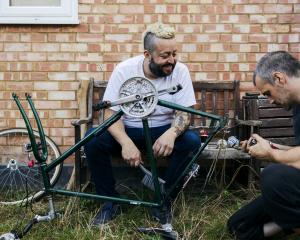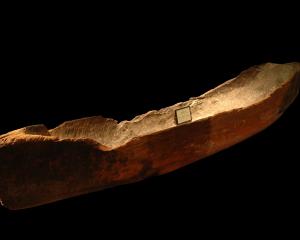For years Cargill's Castle has been a ruin, but in the late 1950s and early 1960s, former Dunedin woman Val Wilson called it home. Janice Murphy goes with her on a trip down memory lane.
It's been 50 years since Val Wilson (nee Neilson) set foot inside Cargill's Castle, but the decades melt away as she reminisces about her time there. In the late 1950s and early 1960s, she, her then husband Rupert Winter and his parents, Tom and Gladys Winter, called it home.
Tom and Gladys ran a popular cabaret there on Saturday nights, with entertainment provided by Rupert Winter's Band (later the Manhattan Skyliners).
The castle was also open for afternoon teas, which attracted older patrons, and private functions, notably parties for sailors from the USS Brough.
"That's my wee ticket office; I sold the tickets from there," Val says, pointing to the former conservatory to the right of the front door.
"And I hung the nappies from a clothesline over there," she adds, pointing past the partly demolished ballroom to the left, where her clothesline used to be strung between two trees.
"It was so windy the nappies didn't hang down, they stuck straight out. I carried the wet washing out through the ballroom."
The remains of a shelter belt planted by the Cargill family on the southern side of the ruins grow at an angle that shows the power of the almost constant wind.
"The Castle" wasn't the perfect place to be a young mother, but Rupert and Val's first two children, Earl and Gale, were born while the couple lived there.
"That was my bedroom, the middle one there," she says, pointing to the first-floor window. "And the lounge was below."
Val remembers tripping at the top of the front steps and rolling down them while clutching baby Gale. "She didn't even cry". Luckily nobody was injured.
A cannon sat either side of the steps in those days, she says, but only the concrete plinths remain.
"How did I bring up babies here?" she asks, looking out at the ocean and the cliffs which fall away steeply behind the ruins.
There was no fence along the cliff in the Winter family's day, and the family mainly spent its time at the front of the house, which was more sheltered and also safer for small children.
A circular driveway looped around the front yard and in the centre was a pond. "Look, it's all overgrown now."
"Oh, but we had fun," says Val, remembering the cabaret nights as she climbs the front steps. "But where's the door? There was a big heavy door, a proper castle door, and beautiful parquetry floors, and a lovely staircase up to the right. I used to have to polish that on my knees.
"And there were two lovely big fireplaces in the ballroom, and great big high-backed seats."The remains of the fireplaces are still visible through the tumbledown walls of the ballroom.
Two private function rooms - the Abercorn and the Connaught rooms, each with an ornate sign over the door and a fireplace - were straight ahead of the main door. The ballroom, where the band would sit in the corner and play, was to the left.
"Oh, it was lovely."
American sailors from the Operation Deep Freeze picket ship USS Brough were frequent visitors to the castle, some with their Dunedin girlfriends. The men from the Brough were well-regarded in Dunedin - 4000 people lined the wharf to farewell the ship on its final departure on February 7, 1959 - and Val remembers dancing with the sailors while Rupert's band played.
Shore patrol would often drop in to check on things.
Police raided the cabaret around 10 o'clock one night, after being told the Winters had allowed patrons to bring their own alcohol. Nothing untoward was found, and a headline in Truth the next week said "Police storm the castle but the band plays on".
The castle had a big upstairs bathroom facing the ocean, and Val remembers sitting in the bath and looking out to sea. "It wasn't classy, but it was nice."
Another bathroom, near the side door and laundry, had a toilet, bath (half of which is still in place) and shower, "but that shower was never used" - because in it was an enormous glass mixing bowl in which Rupert used to make sake and other alcoholic drinks.
Rupert, who still works as a musician in Nelson, says he acquired the bowl from his day job at Columbus Radio, but none of the alcohol was sold to cabaret patrons, though the odd bottle may have been brought up from the cellar to shout for friends.
"We made our money from the cover charge," he says.
Near the bathroom was a spiral staircase, now gone.
The remains of a coal range are still visible in the old kitchen, reached by going down a set of stairs to the right of the main door. The Winters had a less-than-perfect relationship with their landlord, and Val says he once was seen peeking through the kitchen windows trying to see what was happening inside.
Opposite the kitchen was the lounge, and Val remembers a round eight-seater green-topped card table with drawers that the family used as a dining table.
Sometimes at night during the muttonbird (sooty shearwater) migration season they would hear a "plop" on the roof, followed by a loud squawking - muttonbirds stopping to rest.
(Muttonbirds were once plentiful on Green Island, just off the coast. A report in the Otago Witness of January 5, 1884, says: "The birds are wonderfully tame, and easily captured. The holes are not very deep, so that it is easy to reach in and drag them out. They bite and scratch viciously, but a knock on the head soon silences them. It would almost pay to catch them for their feathers, as it would not be difficult to catch some hundred during a night, and they are well feathered.")
Val and Rupert never found Tunnel Beach, the swimming spot reached by stairs John Cargill had cut so his daughters could bathe in private, though they occasionally walked along the clifftops looking.
However, they did find another tunnel by following a "whooshing" sound made by the sea below. Rupert remembers lowering himself into a slit in the clifftop and finding a passage which led to a round chamber.
"Then I felt a puff of air come in and quickly went back up," in case water was coming in.
He recently went in search of that tunnel but could not find it again.
A report in The Timaru Herald of November 15, 1892, describes a very similar "fissure", about 2km from the castle, through which a slim person could slide to reach a "lofty cavern" containing stalactites.
Maori were said to have an underground passage from the clifftop to the beach, the story says. It also refers to steps cut in the sandstone cliff when John Cargill lived nearby, and says the stairway has been "partially ruined by mischievous boys rolling stones down it."
The Winter family had a plan to buy the castle and its grounds, and at one time were offered the buildings along with four acres of land, but a settlement could not be reached.
In the early 1960s they moved on, and their time as kings and queens of the castle was over.
• Valerie Wilson (formerly Winter, nee Neilson) now lives in New South Wales. She returns to Dunedin frequently to visit family. Rupert Winter lives in Nelson, and is still a jazz drummer.












